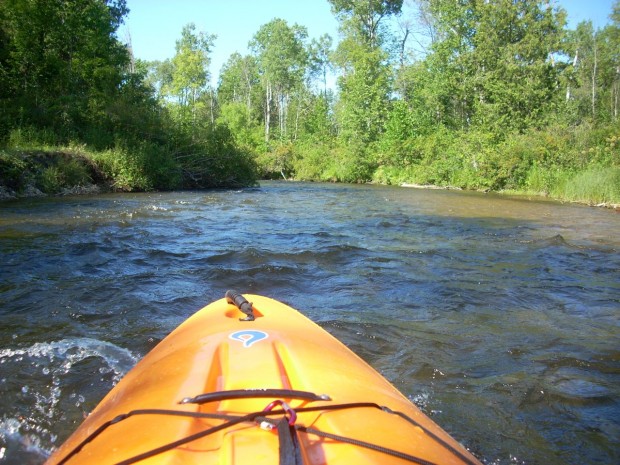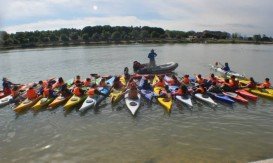
Guadalquivir River, Seville
Seville is the capital and largest city of the autonomous community of Andalusia in the Seville province. The city is situated on the plain of the Guadalquivir River.
Home > WATER SPORTS > Kayaking > Sturgeon River, Cheboygan County
With an average drop of 14 ft (4.26 m), every mile of the Sturgeon River delivers unbeatable kayaking experience. A beautiful canopied river that starts out narrow, but with a strong current and good water level, averaging 3-4 ft/0.91–1.22 m and 6-8 ft/1.83–2.44 m at its deepest point, is full of tricky turns, leaning trees, logs and stumps and will definitely test your abilities. Though Sturgeon is not a whitewater river, you will find its clear water refreshing, as it is common to experience an unplanned dank!
As you maneuver through the Sturgeon River, the wildlife you see along the way or even one of the lovely river cottages of the northern Michigan forests will tempt you to stop paddling, sit back and let the current take you along. You have to keep in mind that you will find many natural obstacles that will challenge you and will require that you stay alert. Remember the water is too cold for unnecessary tip-overs.

Seville is the capital and largest city of the autonomous community of Andalusia in the Seville province. The city is situated on the plain of the Guadalquivir River.

London is the capital city of England and the United Kingdom, being situated on the River Thames. The climate here is classified as a temperate oceanic climate, with chilly winters and warm summers. This exciting city is noted as much for its historical buildings, museums, galleries and attractions as for its sports and leisure activities.
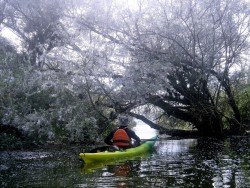
Epirus is a geographic and administrative region, located in northwestern Greece. It is considered to be the region with the more rainfall than any other part of the country. In fact, Epirus offers imposing landscapes of outstanding natural beauty as well as a wide variety of fauna and flora.
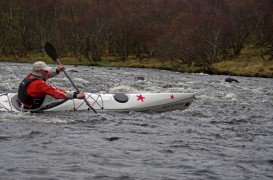
Carmel River State Beach is a state park located in Carmel, north of Big Sur coast in Monterey County, California, USA.
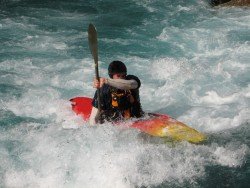
Cagayan River also known as Cagayan de Oro River is a well-known river, draining the north central part of the island of Mindanao in the Philippines.

North Umpqua River is located near Roseburg in southwestern Oregon.
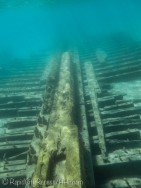
Grand Traverse Bay, a 51 km/ 32 mi long, 16 km/ 10 mi wide bay of Lake Michigan, is divided in two by the old Mission Peninsula. It is coextensive with the Grand Traverse Bay Underwater Preserve that contains numerous shipwrecks. One of the confirmed shipwrecks of the region is the Metropolis.
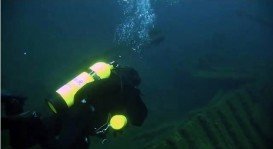
Lake Michigan, the second largest of the Great Lakes of North America by volume and the third largest by surface area, is actually the only one located entirely within the United States. With its basin conjoining with that of Lake Huron to the east and having the same surface elevation, Lake Michigan and Lake Huron are technically a single lake. The large size of the Lakes and the fact that they are prone to sudden and harsh storms increases the risk of water travel and has led hundreds of ships to their end.

Located in Michigan's Upper Peninsula, St. Ignace is the connecting node between the Upper and Lower Peninsula at the northern end of the Mackinac Bridge. Saint Ignace is the second-oldest city founded by Europeans in Michigan and the third oldest continuously inhabited city in the U.S. It is inhabited by Native Americans, Europeans and is rich in history. With its pristine beaches, water filled activities, entertainment, history and annual events, St. Ignace is a great vacation destination for all.
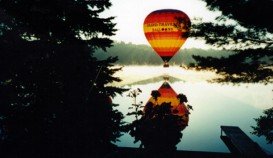
Located at the south end of Grand Traverse Bay, Traverse City is actually a 32 mi (51 km) long, 10 mi (16 km) wide and up to 620 ft (190 m) deep in spots bay of Lake Michigan. Combining varied natural attractions for adventure and/or relaxation, Traverse City is a four-season visitor’s destination.
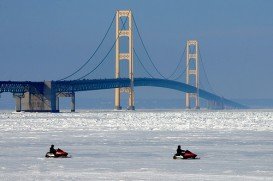
Saint Ignace, the second-oldest city founded by Europeans in Michigan and the third oldest continuously inhabited city in the U.S. Inhabited by Native Americans, Europeans and rich in history, it is mostly known for its ferry service to Mackinac Island and as being home to Straits State Park. Furthermore, the Huron Boardwalk, a number of waterfront parks, the virgin beaches and the St. Ignace – Trout Lake Trail make St. Ignace a great vacation destination for all.
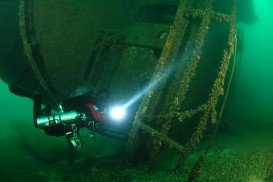
Lake Huron is the second-largest of the Great Lakes and the third largest fresh water lake on Earth, with more than a thousand wrecks being recorded. At least eleven of these shipwrecks are contained in the Straits of Mackinac Shipwreck Preserve. 3 mi/4.8 km east of Mackinac Bridge lies what's left of the Cedarville. Being in a very good condition, because of its close proximity to the surface, the shipwreck has much to explore.
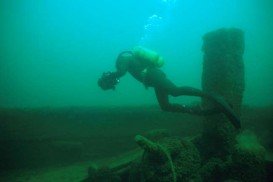
Lake Huron is one of the five Great Lakes of North America and the third largest fresh water lake on Earth. Lake Huron is separated from Lake Michigan by the 5 mi / 8 km wide Straits of Mackinac. The Straits of Mackinac Underwater Preserve shelters many shipwrecks. Among them is the William H. Barnum.
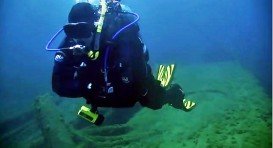
Lake Michigan’s basin is conjoining with that of Lake Huron to the east and having the same surface elevation, they are technically a single lake. The large size of the Lakes and the fact that they are prone to sudden and harsh storms, combined with the rocky shoals and shallows of Straits of Mackinac, increases the risk of water travel and has led hundreds of ships to their end.

